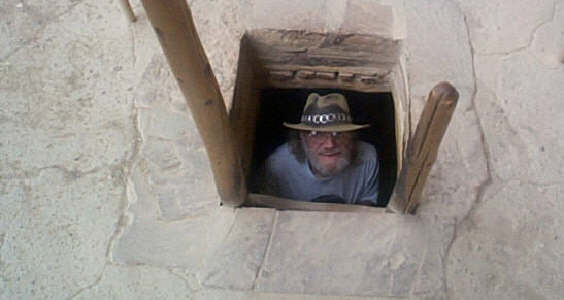
I'm fascinated by Kivas. This is probably partly because of my interest in various world religions and partly because of my experience with shamanistic healing practices.
Kivas are a special characteristic of the Anasazi, Mogollion and later Sinagua and Solado Cultures. Most Kivas are underground but some later Kivas are on the surface. In general, Kivas of the Anasazi are round or oval shaped. Although Kivas are a part of present Native American Pueblo culture, there is little known about them and a lot of misinformation available. I'm sure a lot of this misinformation is perpetuated by the present day Pueblo inhabitants. I'm also sure the missionaries are responsible for a lot of misinformation.
Many Kivas in Mesa Verde are below the floor or ground level. Reasons given are:
|
|
Ascending from a Kiva in the Spruce House Cliff Dwelling. The roof is a reconstruction. During this ascent, I see the relationship between the Kiva entrance and the level of the surrounding plaza. Visible above my head is a cross section of the roof structure of the Kiva showing the logs at the bottom. The logs are covered with a layer of smaller logs at a perpendicular. Next a mass of twigs and smaller materials is added. Over this is a layer of adobe is built to plaza level.
|
The opening of the Kiva into the plaza. The roof level of the Kiva matches the Plaza.. |
A view into a Kiva. The roof fell in over time and the Kiva was excavated by archaeologists. |
|
|
|
These two views of the Kiva show details of the air circulation system. Fresh air is drawn in by the surface air inlet, feeding the fire and providing fresh air to the occupants. In front of the air inlet at the bottom of the wall is an air deflector keeping the incoming air from blowing directly on the fire pit. In the fire pit were probably burned cleansing herbs such as sage. The smoke was exhausted from the entrance hole of the Kiva. As people entered the Kiva they recieved a cleansing from the smoke as they descended the ladder.
The sipapu, according to my reading and the standard park ranger's talks, represented the opening the ancients used to enter this world.
Personal experience in shamanic journeying leads me to believe the sipapu isn't a representation. The sipapu is the shaman's entry to the lower world to obtain information concerning village life and survival and to perform healing functions.
I had a private discussion with a ranger who worked with the Hopi in park evaluation and preservation. The ranger claimed knowledge from the Hopi that couldn't be shared with outsiders but was willing to answer questions as well as they could. I agreed to be discreet and received two answers: "no" and "I can't discuss that." From these answers, I believe several of my interpretations, not in line with standard archaeological interpretation, were correct. I won't share these interpretations because of the implied confidentiality of the discussion.
At my time in life one of my goals is to talk to the spirits of a kiva in a shamanic journey. The purpose of the this journey would be to obtain their permission to journey into the sipapu. Given their premission, I would like to go into a kiva with my drum, rattle, and other sacred instruments and journey down the sipapu.
AWESOME!